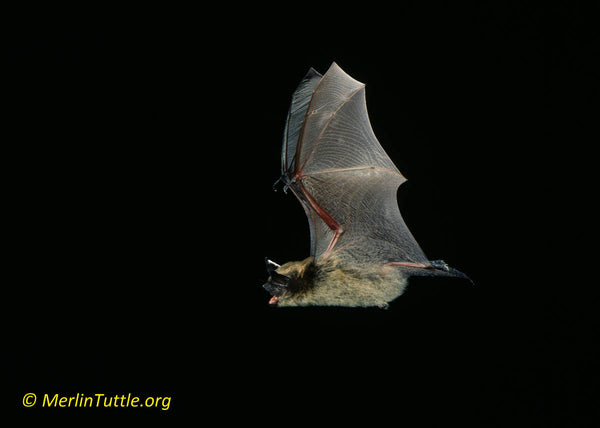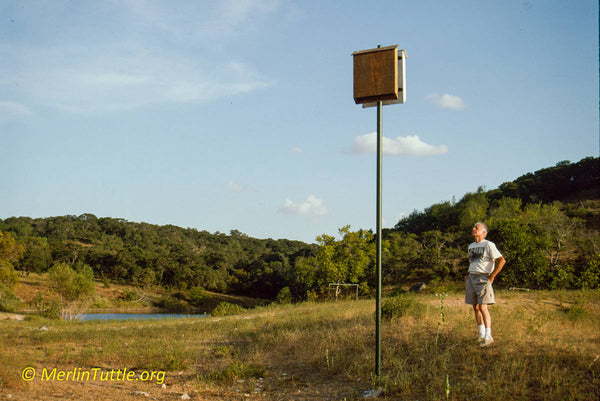Merlin Tuttle's Bat Conservation
The arrival of Zika virus in America has triggered widespread alarm and a search for mosquito control remedies. It is carried by mosquitoes belonging to the genus Aedes that appear to be active both night and day. As in the control of other mosquitoes, a variety of options should be considered.
Existing chemical pesticides typically cause more long-term problems than they solve. Chemical poisons kill natural mosquito predators more effectively than mosquitoes. Over time, predators of mosquitoes such as fish, other insects, and bats (with much smaller populations and slower reproductive rates), die out while mosquitoes develop resistance, multiplying in ever larger numbers in a losing battle often referred to as “the pesticide treadmill.”1 As resistance develops, larger quantities or increased toxicity are required, eventually threatening environmental as well as economic and human health.
Bats are primary predators of the vast numbers of insects that fly at night, and some species consume large numbers of mosquitoes when they are available. However, mosquito control is a complex problem that rarely can be solved by a single approach.
For many years biologists debated whether or not predators, including bats, could help reduce mosquito abundance. Some pointed out that, overall, mosquitoes comprised only a small fraction of prey found in bat stomach and fecal analyses. This is true. But no allowance was made for the fact that studies were often conducted at times and places where mosquitoes were either rare or absent. When mosquitoes are abundant (the only times when we’re concerned!), even some of America’s largest, seemingly unlikely bat species have been found consuming large numbers in a single meal.2

A little brown myotis (Myotis lucifugus) in flight in Wisconsin.
One bat can catch up to 1,000 mosquito-sized insects in a single hour.
Biologists at the University of Michigan were the first to conduct an experimental assessment of the imA little brown myotis (Myotis lucifugus) in flight in Wisconsin. One bat can catch up to 1,000 mosquito-sized insects in a single hour.pact of bats on mosquitoes. They documented that bats can significantly reduce numbers of ovipositing mosquitoes and suggested that “bat predation on mosquitoes could help regulate disease vectors.”3 Claims that bats are irrelevant to pest control typically come from those who benefit from sales of chemical alternatives or bat exclusion services.
Individuals of some bat species can capture up to 1,000 mosquitoes in a single hour,4and large colonies can consume amazing quantities. For example, a Florida colony of 30,000 southeastern bats was calculated to capture 50 tons of insects annually, including over 15 tons of mosquitoes,5 and from 77.4% to 84.6% of little brown bats living in the northern U.S. and Canada eat mosquitoes. 6,7 Because mosquitoes do not take evasive action, and are exceptionally easy to capture, bats sometimes appear to prefer them over larger prey.8,9 Bats can be attracted to live in bat houses,10 and nursing mothers can eat up to their body weight in insects nightly.11
Nevertheless, despite the numbers of mosquitoes that bats eat, simple provision of additional roosts should not be promoted as more than one potentially helpful step toward solving mosquito problems. In some cases bat houses may help and in others, they may not. Bats are one of several groups of animals that naturally prey on mosquitoes. Their relative importance varies from none to high in different locations.
Where human activities have greatly simplified once diverse habitats, predators of pests may decline to the point of irrelevance. For example where single crops cover large areas there may be too few alternative prey between crops to feed insectivorous animals. Loss of biodiversity threatens whole ecosystems, which cannot be restored by simply providing bat houses. Mosquito-eating bats may also die out in some areas due to loss of suitable hibernation caves. Finally, over use of pesticides may preclude help from natural predators in general.
No single approach to mosquito control is appropriate for all locations. However encouraging natural predators should be an important priority in long-term planning. Anything that can be done to facilitate mosquito predation by aquatic insects, fish, or bats may prove helpful.
In areas like Chautauqua, New York, where bats apparently have traditionally played a valuable role, all possible precautions should be taken to ensure their continued presence. And where bats are known to have declined, their recovery should be encouraged.
Putting up bat houses may be quite helpful in places where appropriate bats can be attracted, but even successful bat houses do not always attract a species that feeds heavily on mosquitoes. Some bat-house-dwelling species prefer moths or beetles and may prove more helpful in protecting your yard or garden. Either way, bat houses can be beneficial, and attracting bats is far safer than applying toxic chemicals.
It is unrealistic to even attempt total control of mosquitoes. In most cases, this is impossible for more than brief periods, though mosquito numbers can be substantially reduced. Poisoning will only exacerbate long-term problems.12,13 First lines of defense should always include elimination of as much temporary standing water as possible, and can be as easy as regularly emptying (or changing) water from flower pots, bird baths, clogged rain gutters or other water-holding containers. Such simple approaches can work wonders in reducing mosquitoes. Finally, introducing mosquito-eating fish into permanent ponds and providing roosts for bats can further aid in success. Responsible mosquito reduction typically requires a multifaceted approach.
Bat houses are most likely to succeed where bats are already known to use old buildings. Such roosting habitat is gradually being replaced by structures that are unsuitable for bats, forcing them to find new roosts or die. All American bats are beneficial in keeping the vast numbers of night flying insects in balance, though their primary diets vary considerably.
 Little brown myotis (Myotis lucifugus) living in a bat house in New York.
Little brown myotis (Myotis lucifugus) living in a bat house in New York.Building bat houses is an especially good and timely idea quite aside from any hoped for impacts on mosquito control. Millions of American bats have recently been killed by an accidentally introduced fungus, Pseudogymnoascus destructans.14 It causes white-nose syndrome (WNS). You can help survivors rebuild populations by providing summer homes. Our bats are worth billions of dollars annually in agricultural protection alone.15
Plans for building several kinds of artificial roosts are readily available, including structures capable of housing from dozens to thousands of bats.16 If you’d prefer to buy a bat house, beware of cheap imitations that fail to meet bat needs. The best bat houses will be caulked, tightly sealed and securely put together with screws. All landing and roosting area surfaces will be roughened to provide secure footing for bats (ideally with cross-cut grooves about 1/16th-inch deep). Roosting spaces will be approximately 3/4-inch wide (no less than 1/2 nor more than 1-inch), and the overall external dimensions ideally should be at least 24 inches tall by 14 inches wide. All houses should have a roughened landing area extending 4-8 inches below the entry.
 David Bamberger with his pair of occupied bat houses on his ranch in Texas.
David Bamberger with his pair of occupied bat houses on his ranch in Texas.Both single and multi-chamber houses can be quite successful, though four-chamber houses have proven most attractive for nursery colonies. All houses, prior to mounting, should receive at least three coats of paint to ensure long-lasting weather resistance. Bats do not like drafty or leaky homes. Black houses are best in the coolest climates, ranging from light or medium brown in the hottest. Bats like to have roosting options, so those who put up at least two to three houses, on average double their probability of success.
Location of mounting is also important. The most successful houses are located within a quarter mile of a lake, pond or stream and are at least 10-15 feet above ground. In areas where average day to night temperature fluctuations in summer are less than 20 degrees F, houses can be mounted on poles in back-to-back pairs, facing north-south or east-west. Where day to night temperature fluctuations exceed 20 degrees, they should be mounted only on buildings (which serve as thermal heat sinks). All houses should receive at least six hours of direct daily sun (even in hot climates). In general, more is better. Bats like amazingly warm homes, though in all but the coldest climates bat houses should be equipped with ventilation slots in either the front or sides, approximately 6-8 inches above the entry to prevent over-heating. Houses mounted on or too near trees are least successful, because they are often too shaded and may also be too vulnerable to predators.
Single chamber houses may hold up to 50 bats, usually less, while multi-chamber houses are more likely to attract nursery colonies of up to 200. Exceptionally large artificial roosts have attracted up to 250,000 or more bats. We are happy to provide the most up-to-date advice on these and varied additional options and welcome reports of unusual successes or failures. Contact Merlin at MerlinTuttle.org or John here at jchenger@batmanagement.com
References
- Spooner, A.M. Environmental Science for Dummies. http://www.dummies.com/how-to/content/the- dangers-of-pesticides-in-the-environment.html
- Whitaker, J.O., Jr., C. Maser and L.E. Keller. 1977. Food habits of bats in western Oregon. Northwest Sci., 51:46-55.
- Reiskind, M.H. and M.A. Wund. 2009. Experimental assessment of the impacts of northern long-eared bats on ovipositing Culex (Diptgera: Culicidae) Mosquitoes. J. Med. Entomol. 46(5):1037-1044.
- Rydell, J. 1990. The northern bat of Sweden: Taking advantage of a human environment. Bats, 8 (2):8- 11.
- Zinn, L., and S.R. Humphrey. 1976. Insect communities available as prey and foraging of the southeastern brown bat. Proc. 7th Annual North American Symposium on Bat Research, unpubl. paper presented at symposium.
- Anthony, E.L.P, and T.H. Kunz. 1977. Feeding strategies of the little brown bat, Myotis lucifugus, in southern New Hampshire. Ecology, 58:775-786.
- Fascione, N., T. Marceron, and M.B. Fenton. 1991. Evidence of mosquito consumption in M. lucifugus. Bat Res. News, 32(1):2-3.
- Kalko, E.K.V. 1995. Insect pursuit, prey capture and echolocation in pipistrelle bats (Microchiroptera). Animal Behavior, 50:861-880.
- Rydell, J., D.P. McNeill, and J. Eklof. 2002. Capture success of little brown bats (Myotis lucifugus) feeding on mosquitoes. J. Zool., London, 256:379-381.
- Tuttle, M.D., and M. Kiser and S. Kiser. 2004. The bat house builder’s handbook. Bat Conservation International, Austin, Texas, 35 pp. Revised 24 July 2006
- Kurta, A., G.P. Bell, K.A. Nagy, and T.H. Kunz. 1989. Energetics of pregnancy and lactation in freeranging little brown bats Myotis lucifugus. Physiol. Zool., 62:804-818.
- 2012. Aerial spraying public health hoax. PEEReview, Fall, pp. 1&12.
- Howard, J.J., and J. Oliver. 1997. Impact of Naled (Dibrom 14@) on the mosquito vectors of Eastern Equine Encephalitis Virus. Journal of the American Mosquito Control Association, 13(4):315-325.
- USGS National Wildlife Health Center http://www.nwhc.usgs.gov/disease_information/white- nose_syndrome/
- Boyles, J.G., P.M. Cryan, G.F. McCracken and T.H. Kunz. 2011. Economic importance of bats in agriculture. Science, 332(6025):41-42.
- Tuttle, M.D., M. Kiser and S. Kiser. 2005. The bat house builder’s handbook. Univ. Texas Press, Austin, 35 pp. https://www.amazon.com/Builders-Handbook-Completely-Revised- Updated/dp/0974237914
All text and images protected by copyright. Contact Merlin Tuttle's Bat Conservation
Article date 8/29/16 - Reprinted by Bat Conservation and Management with permission







